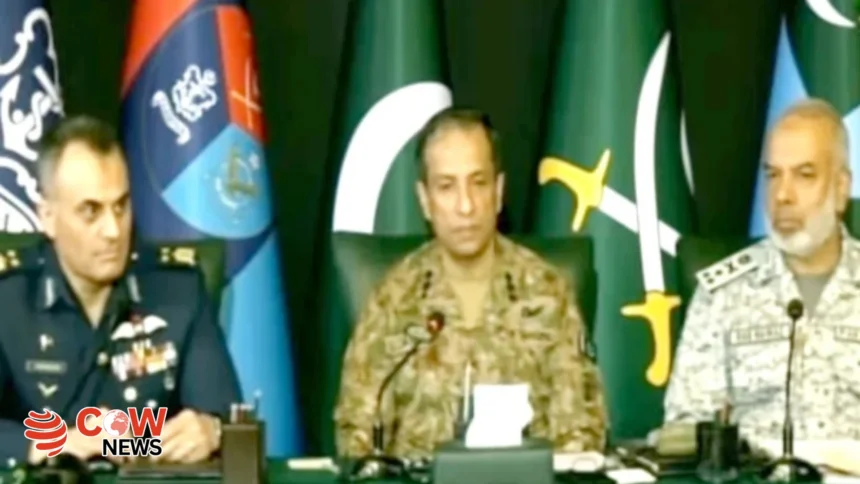Pakistan’s military leadership clarified during a high-level press briefing that the recent ceasefire with India was requested by New Delhi through Washington, not by Islamabad, asserting that the armed forces delivered on their promise to the nation by decisively responding to Indian aggression.
Director General Inter-Services Public Relations (ISPR) Lt. Gen. Ahmed Sharif Chaudhry, flanked by Vice Admiral Rab Nawaz of the Navy and Air Vice Marshal Aurangzeb Ahmed, announced in a joint press conference that Pakistan targeted 26 Indian military installations, including critical airbases and intelligence units. “Our forces, by the grace of Almighty, fulfilled the promise made to the nation. The desire for a ceasefire came from India, conveyed through the United States,” he emphasized.
Lt. Gen. Chaudhry confirmed that Pakistan Air Force successfully destroyed two locations equipped with India’s highly advanced S-400 air defense systems. Targets included installations in Suratgarh, Sirsa, Adampur, Awantipora, Udhampur, and Pathankot. “The Indian military’s command centers used for targeting civilians and supporting proxy terrorism were neutralized,” he added.
Key infrastructure including Uri Network Station and Poonch Radar was also destroyed in a coordinated offensive under “Operation Bunyad-ul-Marsous,” launched during the night of May 6–7 in response to what was described as cowardly Indian aggression that resulted in civilian casualties, including women and children.
The ISPR chief noted the operation demonstrated seamless integration between Pakistan Army, Air Force, Navy, and cyber units. “India was struck simultaneously across land, air, sea, and cyberspace with precision,” he said.
Pakistan’s indigenous missiles — F-1 and F-2 — and long-range aerial munitions were deployed to hit Indian military command and logistical hubs. Airbases across Punjab, Jammu & Kashmir, and northern India, including Bhatinda, Ambala, Halwara, Srinagar, and Anantnag, were reportedly targeted.
Additionally, Pakistani drones flew extensively over Indian territories, including Delhi and Gujarat, to demonstrate surveillance and strike capability, a move intended to debunk the utility of drones in modern warfare when countered effectively.
On the Line of Control (LoC), Pakistani forces repeatedly struck Indian checkposts accused of firing on civilians in Azad Kashmir. “Eventually, these posts raised white flags,” Gen. Chaudhry said, illustrating the psychological impact of Pakistan’s retaliatory actions.
Pakistani strikes reportedly demolished Indian military intelligence facilities in Rajouri that were allegedly supporting terrorist networks inside Pakistan. “Pakistan’s response was precise, restrained, and proportionate — every site targeted was either directly linked to terrorism or civilian casualties,” Gen. Chaudhry stressed.
Vice Admiral Rab Nawaz stated that all Pakistani ports remained fully operational throughout the conflict, and the Indian Navy kept a distance of 400 nautical miles, wary of Pakistan’s maritime readiness. “Next time India thinks of aggression, it must remember our response speaks louder than words,” he warned.
Air Vice Marshal Aurangzeb said PAF successfully safeguarded national airspace, downed intruding Indian aircraft, and targeted hostile drones. He reaffirmed the air force’s commitment to defend Pakistan’s skies.
The DG ISPR thanked all political parties for uniting above differences and standing by the armed forces. He also praised the Pakistani media for resisting Indian disinformation campaigns and youth who played a frontline role in the digital information war.
Emphasizing long-term peace, Gen. Chaudhry stated, “Regional stability is impossible without resolving the Kashmir dispute in line with UN resolutions and the aspirations of its people.” He warned that any ambition to wage war for domestic political goals is a dangerous game with fire between two nuclear-armed states.







